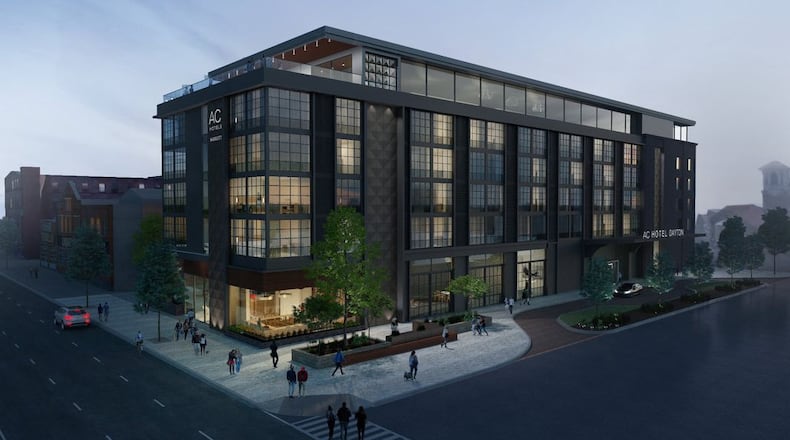A new 120-room hotel called the Hotel Ardent, part of the Tapestry Collection by Hilton, is on track to open along North Main Street in the third quarter of this year, and a 134-room AC Hotel by Marriott located just blocks away is making good progress and should open in early 2023. The Dayton Arcade also is expected to welcome 91 new hotel rooms.
First Hospitality is investing about $27 million to turn the office building at 137 N. Main St. into the Hotel Ardent.
The partners are creating 120 rooms, including suites; a meeting area; exercise facility and a wood-fired restaurant concept called Bistecca, said Stephen Schwartz, chairman of First Hospitality, which is based in Illinois.
Hotel Ardent is a lifestyle brand hotel that will appeal to travelers and consumers who value experiences, instead of a simple bed and bathroom, Schwartz said.
The hotel design and brand emphasize Dayton’s uniqueness and will be a tribute to the community’s ingenuity and creativity, he said.
“Guests who stay with us will know that they are not in a typical, boring branded hotel which could be anywhere,” he said.
A new hotel, called the AC Hotel, is under construction at a site about four blocks from the Hotel Ardent.
The property is along East First Street, across from the Dragons baseball stadium and next to the Mendelsons liquidation outlet building, which also is being redeveloped.
Developers Crawford Hoying and Woodard Development started work on the project in July after a COVID-related delay.
Credit: Marshall Gorby
Credit: Marshall Gorby
The six-story hotel will have an upscale rooftop restaurant and bar with indoor and outdoor spaces called the Foundry, plus a fitness center, meeting spaces, a lounge and a media library.
The hotel, which is expected to open in January 2023, is in a great location and will feature numerous high-end amenities that aren’t currently offered in the market, said Brent Crawford, principal and founder of Crawford Hoying.
The developers, who are behind the thriving Water Street District, opened a 98-room Fairfield Inn & Suites in 2018, just north of the ballpark, at 305 E. Monument Ave.
The Fairfield Inn was the first new hotel constructed downtown in decades, and it has proven popular. Downtown Dayton currently has about 385 rooms, between the Fairfield Inn and the Radisson-Dayton hotel (formerly the Crowne Plaza) across from the Dayton Convention Center, officials say.
Crawford said the developers are confident the market can support this new level of product. He said the Fairfield Inn has been successful.
“Dayton is significantly lagging other cities in the available number of rooms, especially new product,” he said. “The performance of the Fairfield Inn confirms our belief that new product is needed in the market.”
Cross Street Partners, the lead development partner on the Dayton Arcade project, also wants to convert a portion of the complex’s northern buildings into new hotel rooms. Cross Street says it is working on final details and financing for a 91-room hotel.
The hotel will be in the Third Street Arcade and the Gibbons Annex. The original proposal for those buildings was micro unit apartments, but the developer scrapped those plans.
Some local leaders and officials say downtown could use a lot more lodging, especially as the Dayton Convention Center undergoes a major renovation intended to attract more events to the facility.
A study of the Dayton Convention Center and local market concluded that the center could use about 500 new hotel rooms nearby to lure and accommodate more non-local and major events, said Pam Plageman, executive director of the Montgomery County Convention Facilities Authority.
But Schwartz, with First Hospitality, said too much new hotel space could move downtown if developers, investors and lenders aren’t careful.
The Hotel Ardent and the AC Hotel should adequately take care of downtown hotel demand for a while, he said, adding that oversaturation is an issue in the lodging industry and “stupid money does foolish things.”
Schwartz, however, said he thinks that skyrocketing construction costs could put a damper on some additional hotel projects.
Joe Savarise, president and CEO of the Ohio Hotel & Lodging Association, said lodging saturation has not been much of a problem in recent years.
Hotel industry analytics and modeling have become very advanced, he said, and investors and prospective owners and operators are adept at forecasting demand.
Additionally, he said, even a short-term overabundance of rooms could work out in the long run if demand increases, especially as a result of projects like the transformative overhaul of the Dayton Convention Center.
“It is important to take the long-term view when dealing with projects of this nature,” he said.
About the Author






